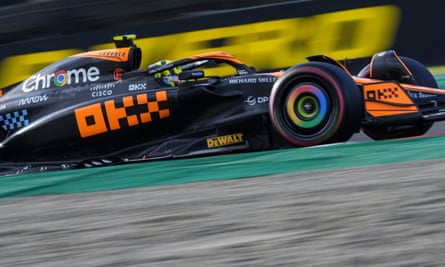
Lando Norris is on positively fine form as he contemplates the pleasure of competing in the Japanese Grand Prix. The young British driver’s good humour is infectious, he is clearly loving racing, especially in his resurgent McLaren, but he is altogether less complimentary in his assessment of the current Formula One regulations that delivered the cumbersome machinery he and the other drivers will race in the early hours of Sunday morning at Suzuka.
In the McLaren hospitality area in Japan, still on a high from a superb second place at the last round in Singapore, the 23-year-old’s tone changes to one of almost quiet exasperation as he laments the restraints the management of modern F1 cars put on drivers. “You feel like you are not driving at 100%, you have to drive at 95% as well as you can,” he says.
“You are not driving at 100% because one slide and you’re done. You are just managing your tyres and your temperatures. It is frustrating, it feels like you are going so slowly. You just want to be able to race closer but as soon as you push, you light up the rears once and it’s game over.”
Norris is one of the young generation of F1 drivers who have known only this formula but his issues with the cars are widely shared across the grid, including among veterans such as Lewis Hamilton. They are all singing from the same song sheet.
“The cars used to be 200kg lighter and that is a lot,” Norris says, with emphasis. “They should make the cars lighter, simple as that. You make them quicker by being lighter, then you can remove some of the aero stuff, which makes all the dirty air, and then you would be able to follow better.”
Norris’s assessment of the weight differential is spot on. The cars are 200kg heavier now than they were 20 years ago. They are bigger, more unwieldy and considerably less agile, as Hamilton has pointed out. “The lighter cars were more nimble, nowhere near as big and so racing, manoeuvring the car, was better,” he says.

At tracks such as Monaco, they are simply too big to compete properly on a track where they lumber round the tight corners of a circuit that belongs to a different time. In 1989 the Ferrari 640 weighed 510kg. At the end of the V8 era in 2013 the cars weighed 640kg. This year the minimum weight is 798kg. They are behemoths in comparison to their predecessors. The 640 was 4.40m long, this season’s crop of cars is more than a metre longer at 5.63m.
Norris took to driving as a child because he adored it, rather than with an F1 career ambition in mind. He had been karting for several years before he considered taking it further. Smaller, lighter and in a less competitive kart than the opposition he admits he was bullied on track but did not care because he loved racing so much. Now at the pinnacle of the sport, he feels the rules do not best showcase the talent on the grid.
Norris is often disarmingly honest, and he knows it sometimes lands him in trouble, but here in Japan he is once more refreshingly straightforward about what the drivers are actually doing. “In Singapore last weekend there were seconds and seconds of every lap of management,” he says. “One hundred metres at a time of lifting and coasting, slowing down, trying to keep the tyres one degree cooler.
“It’s because of the tyres, but that’s because the cars are so heavy you have to make a tyre like this. It’s not to do with Pirelli. Making a tyre that has to deal with the weight of these cars, the power of these cars, the downforce of these cars is a pretty much impossible task. The main thing is the cars need to be made lighter again and things would come back to life.”

The weight has piled on through the turbo-hybrid engines, but also with heavier tyres, bigger fuel tanks since refuelling was banned, the halo device and stronger safety cells. Pointedly Norris cites how F3 cars can take over-driving without hurting the tyres and it even makes him almost wistful for his days in the Ginetta Junior series.
“In Ginettas the racing was always close, you were swapping positions every straight but the way of driving was that you were almost drifting everywhere,” he says with a smile. “Here you can’t be like that. If you make one little mistake then the rear goes. That is a mistake – a mistake is ever having a slide of the rear. Ginetta was not, you were just driving on the edge.”
F1’s chief technical officer, Pat Symonds, wants the cars to become smaller at the next major regulation change in 2026. But while there is an acknowledgement that reducing the weight would be a positive step, the ambition appears to be limited to just ensuring it does not actually increase any more, which suggests the heavy metal formula is set to remain.
They will, of course, look magnificent at Suzuka. This wonderful circuit flatters every vehicle and plays to the strengths of the high-speed cornering of the modern F1 car. Yet, as Norris observes, while they are quick, they are still not quite hitting the mark. “You just want to be able to push it a little bit more,” he says.










 English (US)
English (US)